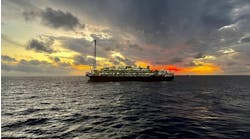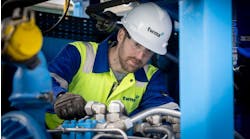Geological similarities with Brazil's pre-salt attract investments to Africa
Peter Howard Wertheim
Contributing Editor
Available data today, mostly provided by 3D seismic, oil and source rock geochemistry, and 3D basin modeling reveals a close match between the South American and West African margin basins with respect to their pre-salt depositional sequences, including reservoir and source facies of the pre-salt tectono-sedimentary sequences.
This strong similarity allows the predictions of huge discoveries of light oil and gas in the pre-salt sequences of Angola, Namibia, Gabon, and Congo, Marcio Mello, president of the Brazilian Association of Petroleum Geologists and CEO of the recently launched Brazilian company HRT Oil & Gas, toldOffshore magazine.
The South Atlantic joined showing the close ties between the sedimentary basins in Brazil and those of West Africa. Map courtesy of HRT Rio de Janeiro.
“With the support of petroleum system technology, it has been proven that there is an almost perfect similarity (duplication) between all the elements and processes of the petroleum system such as source rocks, reservoirs, seals and traps, and oil types of the pre-salt sequences of Brazil when compared with the pre-salt systems of West Africa,” asserts Mello.
However, asymetric rifting has resulted in different subsidence histories, which has, in turn, created major differences in the distributions of oil and gas quality and depth of occurrence. As a result, the Brazilian margin is dominated by Lacustrine black to light oil in the pre-salt sequences. In contrast, West Africa expects a higher amount of light oil/condensate and wet gas. Also, in West Africa the pre-salt reservoirs are found toward higher temperatures and pressures than in its Brazilian counterpart, says Mello.
“What exists in Brazil, exists in Angola, even the rocks containing oil are the same. It’s a certainty, not a possibility. Giant deposits will be found there,” affirms Mello.
Petrobras geologists believe West Africa’s pre-salt geology has many similarities to that of offshore Brazil because, when the single southern subcontinent, dubbed Gondwana began to split into Africa and South America, mirror imaging started.
Since the geological structures in the pre-salt have generally remained unchanged since South America and Africa separated some 165 million years ago, experts say that it is a must to look on the western coast of Africa and the eastern side of Brazil.
Batimetric and magnetometric measures started during the 1940s confirm duplications. During the 1960’s consolidation of the plate tectonics theory, data started to accumulate. That continues today along the South Atlantic margin with the technology of 2010.
Some differences between Brazil and Angola do exist. For example, unlike in Brazil, Angola’s pre-salt region is found offshore and onshore. Angola’s onshore pre-salt is about 4,000 m (13,123 ft) below the ground, while the offshore pre-salt is even deeper.
The common sense is that the salt layer worked as a seal and the geological structures below remained generally unchanged since then. Existing onshore and near-shore pre-salt fields in West Africa provide additional support for the existence of deepwater pre-salt opportunities.
The HRT/African connection
HRT Oil & Gas was launched last year by Brazilian oilfield consultants HRT Petroleum. The company holds operator stakes in 21 blocks in the onshore Solimões basin in Brazil’s Amazonas state.
Mello, who worked as a geologist in Angola, for three years and for 24 years for Petrobras, recently ventured into international waters, gaining the rights to explore three blocks offshore Namibia.
“The basins off Namibia have been forgotten for decades, being overshadowed by the success offshore Angola. Our recent petroleum system modeling and prospect resource analyses have identified large prospects in three of the studied blocks,” says Mello.
“We think there could be more than 5 Bboe in these unrisked prospects with objectives in the Upper Cretaceous turbidite sandstones as well as the syn-rift carbonates and sandstones that are analogous to the Tupi and Jupiter fields in southern Brazil,” he adds.
Brazil (Santos and Campos basins) and on the right side Angola and Gabon pre-salt. Analysis of both the Brazil and West African continents strongly suggest geological features similar to the super-giant Brazilian discoveries also exist in West Africa.
Under its license agreement, HRT will collect and analyze all existing and historical data for blocks 2713A and 2815 and will source potential farm-in partners.
Block 2713A is owned by Universal’s 90% controlled subsidiary Kunene Energy Ltd. Universal Power Corp. has retained HRT Petroleum to do technical analysis on two of its blocks offshore Namibia. Universal currently has a 30% carried interest in block 2815 through Cumoxi Investments Ltd., a 100% owned subsidiary.
Universal Power is an independent oil and gas exploration and development company with broad-based Black Economic Empowerment partnerships. The company currently holds interests in six blocks of offshore concessions covering over 32,000 sq km (12,355 sq mi) in Namibia.
Block 2713A is next to block 2714A owned by Enigma Oil & Gas Ltd. In May of 2009, Petrobras signed a farm-in agreement for a 50% interest in block 2714A. The terms were $16 million cash plus reimbursement of past costs including 3D seismic. The technical work and data room for this project was managed by HRT.
“The special location of both blocks closely associated with the Kudu field and directly related to two very important oil and gas hydrocarbon kitchens located in the southern and western portions of the basin, gives the area a very special geological situation regarding the charge of oil and gas over the structures already envisioned. Based on the current and historical data already analyzed, I am very confident about the oil and gas potential on these blocks,” Mello says.
HRT will operate Orange basin blocks 2813A, 2814B, and 2914A with a 40% stake. Universal Power Corp. will have a 40% share, and Acarus Investments will hold the remaining 20%. The blocks are west and southwest of the Kudu region, where a natural gas deposit holding an estimated 1.3 tcf was recently discovered, HRT says.
The concession license calls for three exploratory periods, with the first lasting four years and encompassing 2D and 3D seismic data. Investments for the first exploration period were pegged at $8.5 million.
HRT Oil & Gas plans to spend in both areas, not only to prove its analyses, but more importantly to certify billions of boe and start production before June 2011.
Sonangol
Sonangol, the national Angolan oil company, recently started preliminary studies into Angola’s pre-salt region. Sebastião Gaspar Martins, head of research at Sonangol, says the company plans to drill one or two pre-salt wells by 2012.
During the last months, the company has been preparing for seismic and other geological studies. After being focused on deepwater and ultra deepwater offshore reserves, Sonangol now expects that the pre-salt is Angola’s next exploration frontier and to assess the overall situation will require spending in the hundred of millions of dollars range.
Luman Sebastião, a geoscientist for Sonangol’s exploration unit, says the pre-salt region in Angola is very large and could hold promising reserves and he also notes that “the Angolan and the Brazilian continental shelves have various similarities, as they have been joined for a certain geological period.”
The interest in pre-salt E&P started growing after Petrobras announced several massive oil finds in the pre-salt area off that country’s coast that together contain dozens of billions of barrels. Oil found in the area is usually in water depths of around 2,000 m (6,560 ft) and several thousand meters further below layers of sand, rocks, and salt, which makes exploration and production challenging and expensive. Angola’s pre-salt reserves could be “gigantic,” and even as big as Brazil’s, Sebastião says.
Cooperation in this field is growing between Sonangol and Petrobras, at present via the start up of a bilateral study of Angola’s pre-salt region. Angola’s studies into its pre-salt area at first are concentrating on the Kwanza offshore and onshore basin, and the Congo basin. At a later stage, Angola plans to study more southern regions.
Petrobras operations in Africa
Petrobras has been buying a lot of acreage offshore Angola, because it can apply its understanding of oilfields offshore Brazil to those offshore Angola.
Jorge Luiz Zelada, Petrobras international director. Photo courtesy of Banco de Imagens Petrobras.
In an exclusive interview for Offshore magazine, Jorge Luiz Zelada, Petrobras international director, presented an overview of the Brazilian company’s activities in Africa.The director pointed out that Petrobras’ latest Business Plan calls for investments of $174.4 billion in the 2009-2013 period. In total, $15.9 billion is earmarked for international activities from 2009 to 2013, about 9% of Petrobras’ total investments.
Petrobras’ fourth biggest international investment, some $900 million for the 2009-2013 period is for Angola. Meanwhile, for the same period, investments planned for Nigeria total $2 billion.
At the time of this writing, Petrobras approved its Business Plan for the 2010-2014 period, which calls for total investments of $224 billion, of which 5% ($11.7 billion) will be allocated for international activities.
Petrobas offshore Angola. In 1997, Petrobas offshore Angola kicked off its activities, and currently works in six offshore blocks there – it operates three exploratory blocks (18/06, 6/06, and 26) and holds stakes in three others (15/06, 2/85, and 34).
Of these six blocks, one is in production (block 2/85), and the other five are in exploration. Sonangol E.P. is the concessionaire of all Angolan blocks that Petrobras has stakes in.
Petrobas holds a 5% stake in block 15/06, and Eni Angola is the operator. Other partners are Sonangol P&P, SSI Fifteen Ltd., Total, Falcon Oil Holding Angola AS, and Statoil Angola Block 15/06 AS.
Petrobras is the operator of block 18/06, with a 30% stake, and has Sonangol Sinopec International - SSI, Sonangol P&P, Falcon Oil, and the Gema Group as its partners there.
Petrobras also holds 27.5% of the equity stakes in block 2/85, and works with Sonangol P&P (operator), Chevron, Somoil, Polyhedron, and Kotoil in it.
Another Petrobras interest: 30% of the stakes in block 34 where it works with Sonangol P&P (operator) and Statoil.
Petrobras is the operator of block 6/06, located in shallow waters, in with a 40% share. Other partners are Sonangol P&P, Interoil, Falcon Oil, and Initial O&G.
In block 26, also in deep and ultra-deep Kwanza basin waters, Petrobras is the operator with 80% interest and works in partnership with Sonangol P&P.
In Namibia, Petrobras has been active since 2009, when it acquired a 50% stake from Chariot to explore block 2714A offshore in the southern part of the country. Chariot’s local subsidiary Enigma is the operator of the block.
Covering an area of approximately 5,500 sq km (2,123 sq mi), in waters ranging from 150 to 1,500 m (492 to 4,920 ft) in depth, the block is located between the Orange and Luderitz sub-basins, at an average distance of 80 km (50 mi) off the coast. A 3D seismic program over 2,500 sq km (965 sq mi) has been carried out for the block. The data are being processed and interpreted.
Petrobras says it is committed to undertake geological and geophysical studies that will allow a model to be developed for the area’s oil system. The company has the option to drop out of the agreement before drilling any wells. The initial exploration period for the block ends in August 2011.
After completing the data evaluation, Petrobras may elect to renew the contract, which includes the commitment to the exploration program to drill an exploratory well. Enigma will remain the operator of the block until the end of the initial exploration period, and Petrobras may take this position later, if it decides to carry on with the activities in the block in the next phase.
In Nigeria, Petrobras started its activities in 1998, in deep Niger River delta waters. The company currently holds interests in three blocks: OML-127 (Agbami) and OML-130 (Akpo), as a non-operator; and OPL 315, as the operator.
The entry into production of the giant fields of Agbami (July 2008) and Akpo (March 2009) turned the country into one of Petrobras’ international production highlights.
In block OML-127, Petrobras has a 13% stake. The project was developed in conjunction with Chevron (operator), Statoil, Famfa, and NNPC. The average water depth at the field is 1,400 m (4,593 ft), and the oil that is lifted there is light, at 45 to 49° API.
In block OML 130 where Petrobras holds a 20% interest, the partners are Total (operator), Sapetro, CNOOC, and NNPC. The oil in this field is also light. Water depths range from 1,200 m (3,937 ft) to 1,400 m (4,593 ft).
Production is carried out at both fields by means of an FPSO capable of producing 250,000 b/d of condensate and of storing up to 2 MMbbl.
In March 2009, the conceptual development plan for Egina field, also in block OML 130, was approved by the government of Nigeria. The development phase and production is estimated to start by 2015.
Forty wells and subsea export facilities, in addition to a new FPSO with capacity to produce 200,000 b/d of oil, are expected to be ordered for operations at the Egina field.
Since February 2006, Petrobas has operated block OPL 315. The company holds a 45% stake in partnership with Statoil and Nigerian Ask Petroleum System. Ranging over a total area of 1,006 sq km (388 sq mi) and at water depths ranging from 1,000 m (3,280 ft) to 2,000 m (6,561 ft), the block is under assessment for drilling planned for this year. The block is on the northern boundary of the Niger River delta.
In Libya, Petrobras owns a 70% stake in the offshore exploratory block Area 18 as the operator and works in partnership with Australia’s Oil Search Ltd.
In Tanzania, Petrobras has a 100% interest in offshore exploratory blocks 5 and 6. The local office started operations in 2009, and since then activities have been related to the 3D seismic. This survey will cover a total area of 2,800 sq km (1,081 sq mi).
In Africa, Petrobras produces in Angola and Nigeria. According to the latest production note that was announced, with data for March 2010, Petrobras’ production on the continent topped-out at 57,444 boe/d, which corresponds to 24% of the company’s total international production.
Other companies in Africa
US independent Cobalt International Energy, Chevron, Anadarko, ExxonMobil, Shell, TOTAL, Maersk Oil, BG Group, Chinese National Offshore Oil Co. (CNOOC), BP, and Petronas, are other companies attracted to offshore West Africa.
By early 2011, Cobalt intends to drill sub-salt wells in Angola. At the turn of the year the company raised $1 billion -- the largest ever US IPO for an exploration and production company -- partly on hopes they will contain reservoirs similar to those found in Brazil.
As it drills farther out in the sea and deeper down, Chevron is inspired by a model 5,000 km (3,107 mi) across the Atlantic Ocean to the coast of South America and particularly Brazil for guidance, say Chevron sources.
Maersk Oil has finalized the appraisal well Chissonga-2 off Angola which was drilled down dip of the Chissonga-1 discovery well in block 16 in 1,355 m (4,445 ft) water depth. The well was drilled to TD of 6,052 m (19,855 ft). One production test was conducted in turbidites of Oligocene age, flowing 6,650 b/d of 36° API oil on a 36/64 in.-choke. Wells will most likely be required to reduce the remaining uncertainties before commerciality can be determined, says the company.
A six-month licensing round from May 2010 to November will offer blocks from two Gabon deepwater basins: Zone Sud, where the targets are pre-salt, and Zone Nord, containing both pre- and sub-salt targets.
Gabon, which was largely ignored, is now showing big potential in the pre-salt section. Much work has been done on source rocks and oil types from both margins of the South Atlantic Ocean, and published work indicates that direct comparisons can be made to pair basins such as the Sergipe basin in the northeastern Sergipe state of Brazil with the North Gabon basin and the Reconcavo basin in Bahia, Brazil, with the South Gabon and Congo basins. However, it is unknown how far offshore the pre-salt reservoir extends.
In Gabon’s onshore and shelf blocks, the pre-salt section has been drilled and discoveries have been made, proving a pre-salt petroleum system is present.







